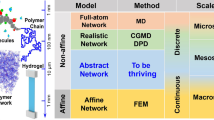Abstract
Rheological properties of hydrogel materials are highly related to the molecular structure of polymeric randomly crosslinked or supramolecular gel networks. The numerical simulation in this paper is focusing on a static picture of the network percolation and defects at a larger scale. In order to predict G (the storage modulus in shear) properly, it is important to obtaining an accurate value of the effective number of network points per unit volume n. A 3D computer model, which includes ten thousand to several hundred thousand polymer chains, has been developed to study the network of the polymer structure; especially to focus on quantitative analysis of network percolation threshold and local defects. The algorithm has successfully found network percolation and identified different types of network defects as expected. Values of shear modulus are estimated from simulation results and compared with rheological measurement and theoretical calculation, which serve as a guidance to better understand the links between shear modulus and rheological percolation.







Similar content being viewed by others
Notes
While a crosslinked system is clearly a solid, a supramolecularly crosslinked system can be both solid- or liquid-like. Furthermore, for soft materials a rheometer, classically used for liquids and polymer melts works significantly better than a standard universal mechanical testing machines, as the forces encountered are much lower.
References
Drury JL, Mooney DJ (2003) Hydrogels for tissue engineering: scaffold design variables and applications. Biomaterials 24:4337–4351
Zhu W, Li YL, Liu LX, Chen YM, Wang C, Xi F (2010) Supramolecular Hydrogels from Cisplatin-Loaded Block Copolymer Nanoparticles and alpha-Cyclodextrins with a Stepwise Delivery Property. Biomacromolecules 11:3086–3092
GhavamiNejad A, Sasikala ARK, Unnithan AR, Thomas RG, Jeong YY, Vatankhah-Varnoosfaderani M, Stadler FJ, Park CH, Kim CS (2015) Mussel-Inspired Electrospun Smart Magnetic Nanofibers for Hyperthermic Chemotherapy. Adv Funct Mater 25:2867–2875
Kumar GG, Hashmi S, Karthikeyan C, GhavamiNejad A, Vatankhah-Varnoosfaderani M, Stadler FJ (2014) Graphene Oxide/Carbon Nanotube Composite Hydrogels-Versatile Materials for Microbial Fuel Cell Applications. Macromol Rapid Commun 35:1861–1865
GhavamiNejad A, Hashmi S, Joh HI, Lee S, Lee YS, Vatankhah-Varnoosfaderani M, Stadler FJ (2014) Network formation in graphene oxide composites with surface grafted PNIPAM chains in aqueous solution characterized by rheological experiments. Phys Chem Chem Phys 16:8675–8685
Goldansaz H, Goharpey F, Afshar-Taromi F, Kim I, Stadler FJ, van Ruymbeke E, Karimkhani V (2015) Anomalous Rheological Behavior of Dendritic Nanoparticle/Linear Polymer Nanocomposites. Macromolecules 48:3368–3375
Hashmi S, GhavamiNejad A, Stadler FJ, Wu DM (2015) Oscillations in modulus in solutions of graphene oxide and reduced graphene oxide with grafted poly-N-isopropylamide. Soft Matter 11:1315–1325
Vatankhah-Varnoosfaderani M, GhavamiNejad A, Hashmi S, Stadler FJ (2015) Hydrogen Bonding in Aprotic Solvents, a New Strategy for Gelation of Bioinspired Catecholic Copolymers with N-Isopropylamide. Macromol Rapid Commun 36:447–452
Guillet P, Mugemana C, Stadler FJ, Schubert US, Fustin C-A, Bailly C, Gohy J-F (2009) Connecting micelles by metallo-supramolecular interactions: towards stimuli responsive hierarchical materials. Soft Matter 5:3409–3411
Zeng F, Han Y, Yan ZC, Liu CY, Chen CF (2013) Supramolecular polymer gel with multi stimuli responsive, self-healing and erasable properties generated by host-guest interactions. Polymer 54:6929–6935
Brassinne J, Gohy JF, Fustin CA (2014) Controlling the Cross-Linking Density of Supramolecular Hydrogels Formed by Heterotelechelic Associating Copolymers. Macromolecules 47:4514–4524
Seiffert S, Sprakel J (2012) Physical chemistry of supramolecular polymer networks. Chem Soc Rev 41:909–930
Sakai T, Matsunaga T, Yamamoto Y, Ito C, Yoshida R, Suzuki S, Sasaki N, Shibayama M, Chung UI (2008) Design and fabrication of a high-strength hydrogel with ideally homogeneous network structure from tetrahedron-like macromonomers. Macromolecules 41:5379–5384
Zhou HX, Woo J, Cok AM, Wang MZ, Olsen BD, Johnson JA (2012) Counting primary loops in polymer gels. Proc Natl Acad Sci USA 109:19119–19124
Chiper M, Hoeppener S, Schubert US, Fustin CA, Gohy JF (2010) Self-Assembly Behavior of Bis(terpyridine) and Metallo-bis(terpyridine) Pluronics in Dilute Aqueous Solutions. Macromol Chem Phys 211:2323–2330
Ahmadi M, Hawke LGD, Goldansaz H, van Ruymbeke E (2015) Dynamics of Entangled Linear Supramolecular Chains with Sticky Side Groups: Influence of Hindered Fluctuations. Macromolecules 48:7300–7310
Kawamoto K, Zhong MJ, Wang R, Olsen BD, Johnson JA (2015) Loops versus Branch Functionality in Model Click Hydrogels. Macromolecules 48:8980–8988
Norisuye T, Takeda M, Shibayama M (1998) Cluster-size distribution of cross-linked polymer chains across the gelation threshold. Macromolecules 31:5316–5322
Zhou HX, Schon EM, Wang MZ, Glassman MJ, Liu J, Zhong MJ, Diaz DD, Olsen BD, Johnson JA (2014) Crossover Experiments Applied to Network Formation Reactions: Improved Strategies for Counting Elastically Inactive Molecular Defects in PEG Gels and Hyperbranched Polymers. J Am Chem Soc 136:9464–9470
Wang R, Alexander-Katz A, Johnson JA, Olsen BD (2016) Universal Cyclic Topology in Polymer Networks. Phys Rev Lett 116:188302
Zhong M, Wang R, Kawamoto K, Olsen BD, Johnson JA (2016) Quantifying the impact of molecular defects on polymer network elasticity. Science 353:1264–1268
Vatankhah-Varnoosfaderani M, Ghavaminejad A, Hashmi S, Stadler FJ (2013) Mussel-inspired pH-triggered reversible foamed multi-responsive gel--the surprising effect of water. Chem Commun 49:4685–4687
Olsen BD, Johnson JA (2013) Reply to Stadler: Combining network disassembly spectrometry with rheology/spectroscopy. PNAS 110:E1973
Stadler FJ (2013) Quantifying primary loops in polymer gels by linear viscoelasticity. Proc Natl Acad Sci U S A 110:E1972
Ferry JD (1980) Viscoelastic Properties of Polymers. John Wiley and Sons, New York,
F.J. Stadler, T. Takahashi, K. Yonetake, Lattice sizes, crystallinities, and spacing between amorphous chains - characterization of ethene−/ɑ-olefin copolymers with various comonomers and comonomer contents measured by wide angle X-ray scattering, e-Polymers, 9 (2009)
Vatankhah-Varnoosfaderani M, Hashmi S, GhavamiNejad A, Stadler FJ (2014) Rapid self-healing and triple stimuli responsiveness of a supramolecular polymer gel based on boron-catechol interactions in a novel water-soluble mussel-inspired copolymer. Polym Chem 5:512–523
GhavamiNejad A, Hashmi S, Vatankhah-Varnoosfaderani M, Stadler FJ (2016) Effect of H2O and reduced graphene oxide on the structure and rheology of self-healing, stimuli responsive catecholic gels. Rheol Acta 55:163–176
Fetters LJ, Lohse DJ, Colby RH (2007) Chain Dimensions and Entanglement Spacings. In: Mark JE (ed) Physical Properties of Polymers, 2nd edn. Springer, Heidelberg,
Acknowledgements
FJS would like to thank the National Science Foundation of China (21574086), Nanshan District Key Lab for Biopolymers and Safety Evaluation (No. KC2014ZDZJ0001A), Shenzhen Sci & Tech research grant (ZDSYS201507141105130), and Shenzhen City Science and Technology Plan Project (JCYJ20140509172719311) for financial support.
Author information
Authors and Affiliations
Corresponding author
Rights and permissions
About this article
Cite this article
Tang, G., Du, B. & Stadler, F.J. A novel approach to analyze the rheological properties of hydrogels with network structure simulation. J Polym Res 25, 4 (2018). https://doi.org/10.1007/s10965-017-1352-y
Received:
Accepted:
Published:
DOI: https://doi.org/10.1007/s10965-017-1352-y






